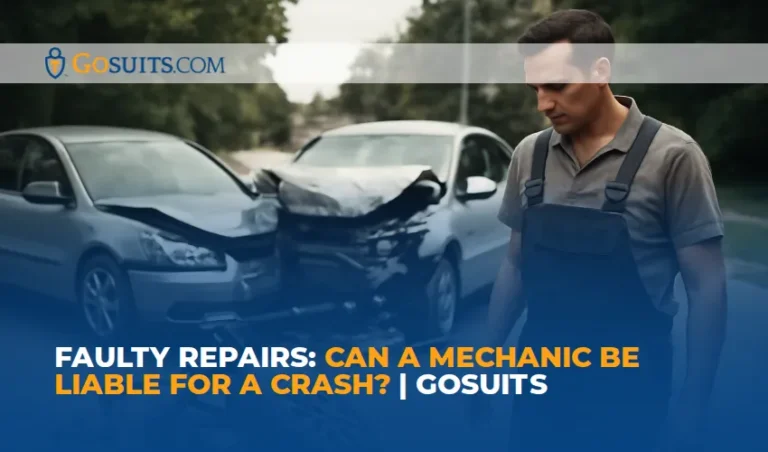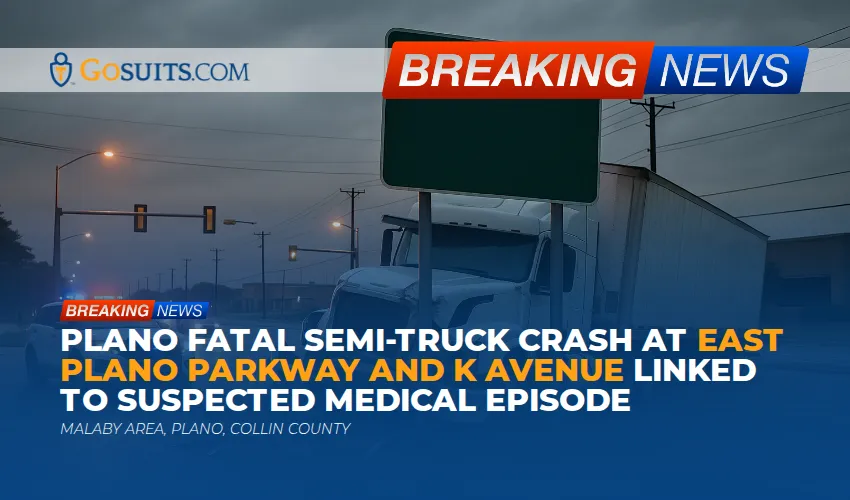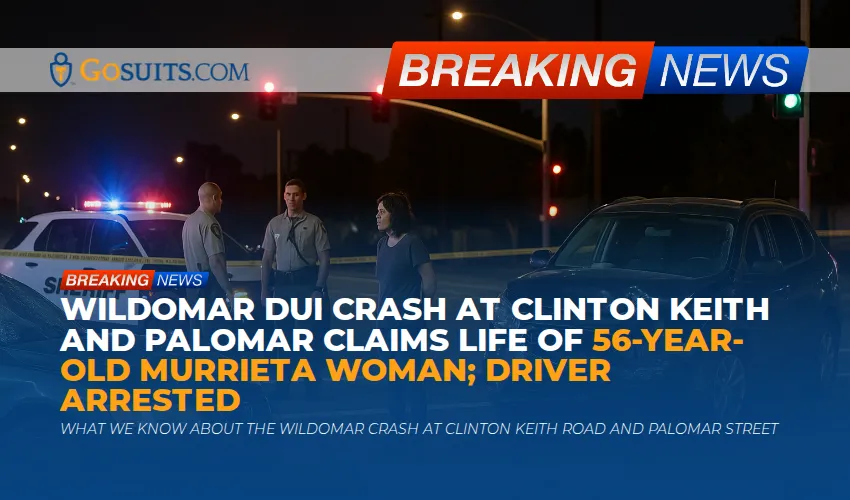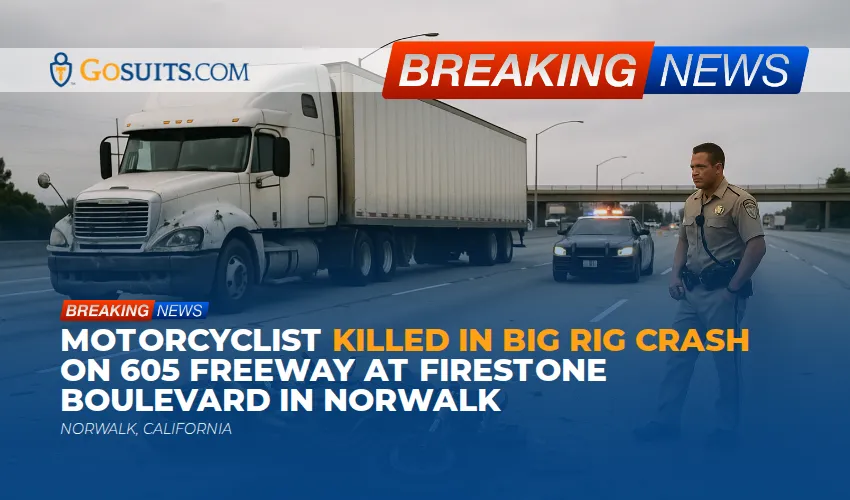- What is mechanic liability for a crash after faulty repairs?
- When can a repair shop be liable for a car accident under negligence law?
- How do defective parts differ from faulty installation, and who is liable?
- What evidence helps prove negligent repair after a crash?
- How do comparative negligence rules in Texas, California, and Illinois affect your case?
- What are the deadlines to sue a mechanic in Texas, California, and Illinois?
- Can you use consumer protection and repair laws for substandard or deceptive repairs?
- Does the auto shop’s insurance cover negligent repair claims?
- How do you start a negligent repair claim and protect evidence?
- How do settlements work when multiple parties share fault?
- What FAQs do Texas, California, and Illinois drivers ask about failed brake repair crashes?
- How can GoSuits help with a negligent repair crash case?
- Sources and further reading
What is mechanic liability for a crash after faulty repairs?
When a vehicle leaves a shop with faulty repairs and later crashes, the injured person may ask whether the mechanic or auto repair shop bears legal responsibility. In civil cases, that question is analyzed under negligence law. Negligence generally requires proof that the repair professional owed you a duty of care, breached that duty by substandard work, and that the breach caused the crash and your damages (Cornell Law School Legal Information Institute).
Crashes have many causes. Nationally, human error accounts for the vast majority of crash “critical reasons,” while vehicle-related issues are much smaller but real. In a federal study of on-scene crash investigations, only about 2 percent of the cases had a vehicle component listed as the critical reason for the crash (NHTSA, Critical Reasons for Crashes). Even so, when a negligent repair is the reason brakes failed, a wheel detached, or steering locked, the shop may be legally liable for the resulting injuries and losses.
Real-world claims rarely target just one party. Your case may involve the driver, vehicle owner, the mechanic, the shop, and sometimes a parts manufacturer. Understanding how negligence, product liability, and comparative fault rules interact in Texas, California, and Illinois helps you plan the right strategy.
When can a repair shop be liable for a car accident under negligence law?
Courts look at four building blocks of negligence: duty, breach, causation, and damages. Although the precise phrasing varies by state, the structure is consistent.
- Duty of care: Repair professionals must use reasonable care and skill when inspecting, diagnosing, repairing, and testing vehicles before returning them to the road. Negligence is the failure to use such care (Cornell LII).
- Breach of duty: Examples include installing the wrong part, failing to torque critical bolts, ignoring clear diagnostic trouble codes, or not test-driving a vehicle after brake service when a test is standard practice.
- Causation: You need evidence linking the faulty repair to the crash. For example, if a caliper was installed backward and the brake pedal went to the floor, contemporaneous physical evidence and expert mechanic testimony can connect the dots.
- Damages: Medical bills, lost income, pain and suffering, and property losses must be proven with records and testimony.
State-level guidance underscores these elements:
- Texas: Texas courts require duty, breach, and proximate cause resulting in damages. See discussion of negligence principles in Texas Supreme Court opinions, such as Nabors Drilling USA, Inc. v. Escoto and Lee Lewis Construction, Inc. v. Harrison.
- California: California follows comparative negligence principles, and negligence turns on whether the defendant failed to use reasonable care under the circumstances. The statewide shift to comparative negligence began with Li v. Yellow Cab Co..
- Illinois: Illinois courts also apply the traditional duty-breach-causation-damages test. See the state supreme court’s causation discussion in Abrams v. City of Chicago.
Negligent repair claims often run alongside claims against a negligent driver. You may pursue all responsible parties in one lawsuit, and the court or jury can apportion fault among them.
How do defective parts differ from faulty installation, and who is liable?
A crash can stem from either a defective part or a correct part installed incorrectly. The legal theories differ.

- Defective parts: If a brake hose, rotor, or steering component was defectively designed or manufactured, you may have a product liability claim against the manufacturer or seller. California’s modern strict product liability doctrine began with Greenman v. Yuba Power Products. Texas codifies several product-liability rules in Chapter 82 of the Civil Practice and Remedies Code, including seller indemnity provisions (Tex. Civ. Prac. & Rem. Code ch. 82). Illinois has statutes that govern product claims and repose periods (735 ILCS 5/13-213).
- Faulty installation or negligent service: When the part is fine but the service is substandard, the claim is negligence against the mechanic or shop. Examples include using contaminated brake fluid, failing to bleed brakes properly, misrouting a belt, or not securing a wheel to spec.
Sometimes both theories apply. For example, a mechanic could negligently fail to detect a known defect covered by a manufacturer’s recall, and a faulty part could also be defective in manufacture. In that case, you might bring both negligence and product claims, then use discovery to determine the true cause.
Warranties can also matter. If the shop sold you a part, implied warranties of merchantability and fitness may apply to the sale of goods, depending on the state’s Uniform Commercial Code:
- Texas: Tex. Bus. & Com. Code § 2.314 and § 2.315.
- California: Cal. Com. Code § 2314 and § 2315.
- Illinois: 810 ILCS 5/2-314 and 5/2-315.
What evidence helps prove negligent repair after a crash?

Proving a negligent repair auto accident requires prompt, careful evidence collection. Many cases turn on documentation that the shop created or should have created, and physical proof on the vehicle.
- Repair orders and written estimates: In California, shops must provide written estimates and obtain authorization before work, which helps prove exactly what was promised and done (Cal. Bus. & Prof. Code § 9884.9; see also consumer guidance from the state’s Bureau of Automotive Repair, BAR consumer rights).
- Parts, invoices, and return policies: Keep all parts returned to you. If the shop did not offer to return replaced parts where required, note that in writing.
- Maintenance and service history: Prior work can show repeated complaints or missed diagnoses. It also matters for comparative negligence if regular maintenance was not performed.
- Diagnostic data and EDR: Many vehicles store event data that can capture braking, speed, and throttle input near a crash. Federal regulations describe minimum data elements for certain event data recorders (49 CFR part 563).
- Recalls and technical service bulletins: Check the federal recall database to see if your vehicle had an open recall related to the failed system (NHTSA recalls). Technical service bulletins can also identify known issues (NHTSA TSBs).
- Photographs and teardown inspection: Photographs of the failed component, fluid leaks, stripped threads, or missing fasteners are persuasive. Arrange for an independent teardown by a qualified mechanic if safe to do so.
- Independent testimony: Courts commonly hear from qualified automotive professionals who can explain the standard of care and whether the shop deviated from it.
- Accident reconstruction: In serious cases, reconstruction can link the mechanical failure to the crash sequence.
Preserve the vehicle and failed parts in their post-crash condition. Avoid repairs or disposal until all parties have had a chance to inspect. Courts can sanction parties for spoliation of evidence, including adverse inferences. Federal rules address loss of electronically stored information (Fed. R. Civ. P. 37(e)). States handle physical evidence spoliation differently: Texas addresses spoliation as an evidentiary issue (Brookshire Brothers, Ltd. v. Aldridge), California does not recognize a separate tort for spoliation (Cedars-Sinai Medical Center v. Superior Court), and Illinois recognizes negligent spoliation under general negligence principles (Boyd v. Travelers Insurance Co.).
How do comparative negligence rules in Texas, California, and Illinois affect your case?
Comparative negligence changes how your recovery is calculated when multiple parties share fault, including you, another driver, the vehicle owner, or the shop.
- Texas: Texas uses proportionate responsibility. You cannot recover if you are more than 50 percent at fault, and your damages are reduced by your percentage of responsibility (Tex. Civ. Prac. & Rem. Code ch. 33).
- California: California uses pure comparative negligence. Your damages are reduced by your percentage of fault, regardless of how high your percentage is (Li v. Yellow Cab Co.).
- Illinois: Illinois uses modified comparative negligence with a 51 percent bar. A plaintiff more than 50 percent at fault cannot recover, and otherwise the award is reduced accordingly (735 ILCS 5/2-1116).
These rules often arise in failed brake repair accident cases. For example, a shop might be assigned fault for a negligent brake job, the vehicle owner for delaying service, and another driver for following too closely. The specific allocation affects the final settlement or verdict.
What are the deadlines to sue a mechanic in Texas, California, and Illinois?
Time limits are critical. Missing a statute of limitations can end a claim. Some product claims also face statutes of repose.
- Personal injury from negligent repair:
- Texas: Generally 2 years from the date of injury (Tex. Civ. Prac. & Rem. Code § 16.003).
- California: 2 years from injury (Cal. Code Civ. Proc. § 335.1).
- Illinois: 2 years for personal injury (735 ILCS 5/13-202).
- UCC warranty claims related to parts sold:
- Texas: 4 years from breach, typically when tender of delivery occurs (Tex. Bus. & Com. Code § 2.725).
- California: 4 years from breach (Cal. Com. Code § 2725).
- Illinois: 4 years from breach (810 ILCS 5/2-725).
- Product liability statutes of repose:
- Texas: A 15-year repose generally applies to product claims from the date of sale (Tex. Civ. Prac. & Rem. Code § 16.012).
- California: No general product-liability statute of repose by statute; case law and equitable doctrines govern timing.
- Illinois: Repose limits apply to product claims, generally 12 years from first sale by any seller or 10 years from first sale to the initial user, whichever is shorter (735 ILCS 5/13-213).
Special rules can toll or extend deadlines, such as when injuries are discovered later. Because deadlines vary by claim type and state, talk with a Texas car accident lawyer or a California or Illinois attorney promptly to protect your rights.
Can you use consumer protection and repair laws for substandard or deceptive repairs?
Yes. In addition to negligence, several consumer statutes may apply:
- Texas: The Deceptive Trade Practices-Consumer Protection Act bars false, misleading, or deceptive acts and certain breaches of warranty in consumer transactions, including repair services (Tex. Bus. & Com. Code § 17.46).
- California: The Automotive Repair Act requires written estimates, authorization, and clear billing. Violations can support civil claims and complaints to the state’s Bureau of Automotive Repair (Cal. Bus. & Prof. Code § 9884.9; BAR consumer rights).
- Illinois: The Automotive Repair Act governs estimates and disclosure for repairs (815 ILCS 306). The Consumer Fraud and Deceptive Business Practices Act also provides remedies for deceptive practices (815 ILCS 505).
These statutes can provide additional leverage if the shop misrepresented repairs, charged for work not performed, or returned the vehicle in an unsafe condition.
Does the auto shop’s insurance cover negligent repair claims?
Most reputable shops carry liability coverage for injuries and property damage arising from their operations, including negligent repair. Policies can include general liability and specialized coverages for garage operations and vehicles in their care. The specific policy language controls whether a negligent repair auto accident is covered and how defense is handled. Because policy terms and state insurance regulations vary, a formal claim and policy review are often necessary to confirm coverage and limits.
How do you start a negligent repair claim and protect evidence?
Early action can make or break a mechanic’s negligence claim. Consider these steps:
- Get legal help promptly: These cases are technical. A lawyer can coordinate inspections, engineers, and automotive professionals and handle communications with insurers for drivers, shops, and manufacturers.
- Send preservation letters: Put the shop and any potential defendants on notice to preserve repair orders, estimates, communications, surveillance video, and the failed parts. Cite the duty to preserve evidence. For electronic data, courts can sanction spoliation under the federal rules when applicable (Fed. R. Civ. P. 37(e)). Texas addresses spoliation with evidentiary remedies (Brookshire Brothers). Illinois recognizes negligent spoliation under general negligence principles (Boyd).
- Secure the vehicle: Store the vehicle and parts safely. If your insurer wants to move or salvage it, get a written agreement protecting your right to inspect.
- Arrange an independent inspection: A neutral, well-documented teardown can reveal improper torque, cross-threaded fasteners, worn or incorrect parts, contaminated fluids, or misrouted hoses.
- Collect your records: Gather all prior maintenance and service records, even from other shops. Patterns of complaints help prove notice and foreseeability.
- Check recalls: Search your VIN for open recalls that might intersect with the failure mode (NHTSA recalls).
How do settlements work when multiple parties share fault?
Multi-defendant cases, such as a negligent repair auto accident with both a shop and another driver involved, typically settle after insurers negotiate each party’s share of fault and damages.
- Texas: Liability is several, with important exceptions. Allocation follows proportionate responsibility rules, and a defendant generally pays only its percentage of damages unless statutory thresholds apply (Tex. Civ. Prac. & Rem. Code ch. 33).
- California: Under Proposition 51, defendants are jointly and severally liable for economic damages but only severally liable for noneconomic damages (Cal. Civ. Code § 1431.2).
- Illinois: Joint and several liability is limited. Defendants less than 25 percent at fault are only severally liable for nonmedical damages, while greater fault can trigger broader responsibility (735 ILCS 5/2-1117).
These rules matter when evaluating a settlement for accidents after repair, because they influence negotiation leverage and contribution rights among defendants.
How can GoSuits help with a negligent repair crash case?
When you suspect a faulty repair caused a crash, having a focused legal team handle the technical details can protect your claim. GoSuits personal injury lawyers handle civil crash cases across Texas, California, and Illinois, including negligent repair auto accident claims where mechanics and shops may share responsibility with drivers and parts manufacturers.
How does a free consultation help you right now?
We are available 24/7 for a free consultation to listen to what happened, review your repair paperwork, and outline practical next steps to secure the vehicle and evidence. Early planning can prevent lost records, salvaged cars, or altered parts.
What availability and communication do we offer?
- Always on: Available 24/7. An attorney and staff member are on call at all office locations to take your call any time.
- Immediate response: Same-day case setup and initial action plan, including sending preservation requests to shops and insurers when needed.
- Multilingual support: We provide multilingual customer service, with 24/7 Spanish and Farsi speakers available.
- Clear updates: You get regular updates at each stage, from investigation through negotiation and, if needed, litigation.
What are our fee policies and cost transparency?
- No win, No Attorney Fees: You pay no attorney’s fees unless we obtain a recovery.
- No hidden administrative fees: We keep billing straightforward and discuss case costs in advance.

How do our tools and case workflow help your claim?
- Proprietary case software: We use in-house personal injury software to move your case faster, from investigation and evidence collection to drafting demands, negotiating with multiple insurers, filing suit, and managing discovery.
- Evidence-first workflow: For faulty repairs car accident claims, we quickly secure the vehicle and failed parts, request shop records, and coordinate independent inspections that address breach of duty, causation, and damages.
What is our experience and track record?
- 30 years of combined experience: Our team has litigated more than 1,000 cases, with published settlement and verdict results available here: GoSuits prior cases.
- Complex cases across three states: We litigate severe injury and complex litigation matters in Texas, California, and Illinois, including product liability claims, 18-wheeler collisions, brain injury, and spinal injury cases.
- Qualified professionals: In cases involving defect analysis or intricate repair standards, we retain credentialed specialists within the state to establish liability and causation.
Awards and recognition
- TopVerdict: Recognized for leading settlements and verdicts across multiple U.S. counties.
- Top 100 Settlement in Texas: Recognition for significant results.
- National Trial Lawyers: Sean Chalaki listed in Top 40 Under 40.
- Best Lawyers: Recognized in 2023, 2024, and 2025.
- Super Lawyers: Honored since 2021.
Community involvement
- Local engagement: Active in schools, chambers of commerce, and nonprofit foundations.
- Professional leadership: Board roles with the Texas Trial Lawyers Association and membership in consumer protection groups.
Where are we located and how can we help immediately?
We serve clients throughout Texas, California, and Illinois, with teams available in and around Houston, Dallas, Austin, San Antonio, and Fort Worth; Los Angeles, San Diego, San Jose, San Francisco, Sacramento, and Orange County; and Chicago, Cook County, Naperville, and Aurora. An attorney and staff member are available at all locations 24/7 to begin protecting evidence and coordinating inspections. We can help you immediately by contacting the auto shop, sending preservation notices, securing the vehicle and parts, and initiating communications with insurers and responsible parties.
We are not a volume firm. Our strength is meticulous preparation and communication, supported by technology and a focused caseload. If you are searching for a faulty repair accident attorney near me or a car accident lawyer for negligent repairs in Texas, California, or Illinois, we are ready to talk and help you take the next step today.
Sources and further reading
- Cornell Law School LII: Negligence
- NHTSA: Critical Reasons for Crashes Investigated in the NMVCCS
- 49 CFR part 563: Event Data Recorders
- NHTSA: Vehicle Recalls
- NHTSA: Technical Service Bulletins
- Federal Rule of Civil Procedure 37(e)
- Brookshire Brothers, Ltd. v. Aldridge, 438 S.W.3d 9 (Tex. 2014)
- Cedars-Sinai Medical Center v. Superior Court, 18 Cal.4th 1 (1998)
- Boyd v. Travelers Insurance Co., 652 N.E.2d 267 (Ill. 1995)
- Texas Civ. Prac. & Rem. Code ch. 33: Proportionate Responsibility
- Li v. Yellow Cab Co., 13 Cal.3d 804 (1975)
- Illinois Comparative Negligence, 735 ILCS 5/2-1116
- Texas Statute of Limitations, Tex. Civ. Prac. & Rem. Code § 16.003
- California Statute of Limitations, CCP § 335.1
- Illinois Statute of Limitations, 735 ILCS 5/13-202
- Texas Product Liability Repose, Tex. Civ. Prac. & Rem. Code § 16.012
- Illinois Product Liability Repose, 735 ILCS 5/13-213
- UCC Warranties, Texas § 2.314 and § 2.315
- UCC Warranties, California § 2314 and § 2315
- UCC Warranties, Illinois 2-314 and 2-315
- Texas DTPA, § 17.46
- California Automotive Repair Act, § 9884.9
- Illinois Automotive Repair Act, 815 ILCS 306
- Illinois Consumer Fraud Act, 815 ILCS 505
- California Prop 51, Civ. Code § 1431.2
- Texas Product Liability, Tex. Civ. Prac. & Rem. Code ch. 82
- Greenman v. Yuba Power Products, 59 Cal.2d 57
What FAQs do Texas, California, and Illinois drivers ask about failed brake repair crashes?
How do I prove a breach of duty by a mechanic?
You must show the shop failed to use reasonable care under the circumstances. Strong evidence includes authorized estimates and repair orders, proof of the parts used, torque specs and whether they were followed, diagnostic codes, post-repair test drive notes, and an independent inspection that explains what went wrong. California’s Automotive Repair Act documentation requirements can be powerful proof of deviations from accepted practice (Cal. Bus. & Prof. Code § 9884.9).
Is a failed brake repair accident always the shop’s fault?
No. A crash can involve multiple contributing causes: driver behavior, road conditions, vehicle load, or a defective part. The data show vehicle issues are a small slice of crash critical reasons overall, about 2 percent in a national study (NHTSA). Comparative negligence rules in Texas, California, and Illinois allocate fault among all responsible parties.
Can I sue a mechanic for a car accident if they performed only an inspection?
Possibly. If the inspection fell below the standard of care and missed obvious, dangerous defects that a reasonable inspection would catch, a negligence claim may exist. Proof usually requires inspection checklists, the technician’s notes, and testimony explaining what a competent inspection entails.
What if a defective part caused the crash, not the installation?
You may have a product liability claim against the manufacturer or seller. In Texas, product liability is addressed in Chapter 82 of the Civil Practice and Remedies Code (Tex. Civ. Prac. & Rem. Code ch. 82). California recognizes strict product liability under case law starting with Greenman. Illinois products claims are also governed by statute and common law, with repose limits (735 ILCS 5/13-213).
What if the shop ignored an open recall on my vehicle?
Recall status is public, and failing to address a safety recall during relevant repairs can support negligence arguments, depending on the circumstances. Check your VIN for recalls (NHTSA recalls).

Do I need expert mechanic testimony to win?
Most negligent repair cases benefit from testimony by a qualified automotive professional who can explain the standard of care and causation in plain terms. In complex failures, engineering testimony may also be useful.
How long do I have to file in Texas, California, and Illinois?
Personal injury claims are generally two years in all three states, subject to important exceptions and tolling rules (Texas § 16.003; California § 335.1; Illinois § 13-202). Warranty and product claims have different timelines.
What should I do immediately after a suspected negligent repair crash?
Get medical care, preserve the vehicle and parts, photograph everything, secure your repair records, and contact a lawyer. Consider a preservation letter to the shop and any insurers. Avoid authorizing repairs until your legal team approves a documented inspection plan.






